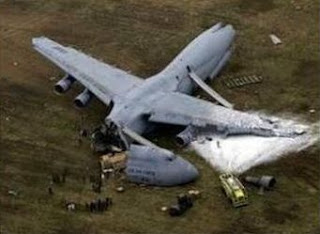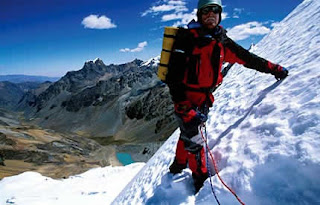Aron Ralston: Amputated his lower right Arm to Survive the Mountains
On May 2003, while Aron Ralston was on a canyoneering trip in Blue John Canyon (near Moab, Utah), a boulder fell and pinned his right forearm, crushing it.
After trying for five days to lift and break the boulder, desperation took him to great measures like carving his name, date of birth and date of death into the boulder, drinking his own urine because of lack of water and videotaping his last goodbyes to his family.
 Finally, a dehydrated and delirious Ralston decided to bow his arm against a chockstone and snap the radius and ulna bones. Using the dull blade on his multiuse tool, he cut the soft tissue around the break.
Finally, a dehydrated and delirious Ralston decided to bow his arm against a chockstone and snap the radius and ulna bones. Using the dull blade on his multiuse tool, he cut the soft tissue around the break. He then used the tool's pliers to tear at the tougher tendons. After Ralston was rescued, his arm was retrieved by park authorities and removed from under the boulder. It was cremated and given to Ralston. He returned to the boulder and left the ashes there.
Vesna Vulovic: The Stewardess Who Survived a terrorist attack at 33,000 feet
On January 26, 1972, a Yugoslav Airlines DC-9 departed from Copenhagen for Belgrade (via Zagreb) with 28 passengers and crew. At an altitude of 33,000 feet, a bomb in the cargo section, planted by the Ustashe Croatian separatist group, exploded. The plane disintegrated and crashed on the mountains.
In what must be one of the greatest survival stories of all time, stewardess Vesna Vulovic survived the 33,000 foot descent sitting on the tail of the plane.
 22 year old Vulovic wasn't even supposed to be on that plane. As she later stated in an interview, it was another Vesna who was supposed to be on that flight, but she was happy with the mix-up as it allowed her to make her first trip to Denmark. She ended up with a fractured skull, two broken legs, and three broken vertebrae - one of which was crushed and left her paralyzed from the waist down.
22 year old Vulovic wasn't even supposed to be on that plane. As she later stated in an interview, it was another Vesna who was supposed to be on that flight, but she was happy with the mix-up as it allowed her to make her first trip to Denmark. She ended up with a fractured skull, two broken legs, and three broken vertebrae - one of which was crushed and left her paralyzed from the waist down. Vulovic spent several months in and out of hospitals; operations allowed her to walk again. She became a celebrity when the Guinness Book of World Records invited her to a ceremony in London with Paul McCartney. She is listed for surviving the longest fall without a parachute. Vulovic is now a national hero in Serbia and spent the late 90s marching in Belgrade against Slobodan Milosovic.
Frane Selak: Escaped from a derailed train, a door-less plane, a bus crash, a car into flames, another 2 car accidents... then won Million Dollar lottery!
Luck has always been on his side or vice versa for croatian music teacher Frane Selak (born in 1929), who is well known around the world for as many fatal accidents as spectacular escapes. The first of his numerous near-death experiences began on a cold January day in 1962, when Selak was on a train to Dubrovnik: it suddenly derailed into an icy river, killing 17 passengers. He managed to escape with a broken arm, minor scratches and bruises.
A year later, Selak was flying, from Zagreb to Rijeka, when a door abruptly blew away from the cockpit of the plane, as he was blown off the plane. The accident killed 19 people, however, Selak was lucky enough to land on a haystack, and wake up some days later in hospital, with minor injuries.
It was in 1966 that he met with the third misadventure while traveling on a bus that crashed and plunged into a river. There were four people dead. Astonishingly, Selak managed to escape unharmed again.
 In 1970, Selak was driving along when, all of a sudden, his car caught fire. He was fortunate again to have left the car before the fuel tank exploded. Three years later, another of Selak’s car caught fire, blowing flames through the air vents. To a greater dismay, Selak's lost most of his hair.
In 1970, Selak was driving along when, all of a sudden, his car caught fire. He was fortunate again to have left the car before the fuel tank exploded. Three years later, another of Selak’s car caught fire, blowing flames through the air vents. To a greater dismay, Selak's lost most of his hair. In 1995, Selak was in Zagreb when he was hit by a bus, again leaving nothing but a few injuries. The following year, while driving through a mountain road, Selak drove off a guardrail to escape an oncoming truck and landed on a tree to watch his car explode 300 feet below.
In a surprising turn of events in 2003, Selak won the million-dollar Croatian lottery, turning the man into either the world’s unluckiest man, or the world’s luckiest one.
Andes Survivors: Crashed on the Andes Mountains, lasted 72 days
On Friday the 13th of October, 1972, a Uruguayan Air Force twin turboprop Fairchild FH-227D was flying over the Andes carrying Stella Maris College's "Old Christians" rugby union team from Montevideo, Uruguay, to play a match in Santiago, Chile. When the plane was flying through the pass in the mountains, the pilot notified air controllers in Santiago that he was over Curicó, Chile, and was cleared to descend. This would prove to be a fatal error. Since the pass was covered by the clouds, the pilots had to rely on the usual time required to cross the pass (dead reckoning). However, they failed to take into account strong headwinds that ultimately slowed the plane and increased the time required to complete the crossing. As a result, the turn and descent was initiated too soon, before the plane had passed through the mountains. Dipping into the cloud cover while still over the mountains, the Fairchild soon crashed on an unnamed peak (later called Glacier of Tears), located between Chile and Argentina.
Twelve people died in the crash. Survivors not only had to withstand the hunger and the fearful Mountains, but also 30 degree-below-zero temperatures during the night. They tried to survive with the scarce food reserves they had until being rescued, but they lost their hope when heard that the search had ceased on the radio. Desperate owing to the lack of food and physically exhausted, they were forced to feed themselves on their death partners to keep on living. Finally fed up with the extremely low temperatures and the avalanche threats, as well as anguished by the continuos deaths of their partners and the bad rescue prospects, two of them decided to cross the huge mountains to reach Chile. On 22nd of December of 1972, after being isolated for 72 days, the World found out and knew there were 16 survivors that beat Death in the Andes mountains.
Anatoli Bugorski: The Man Who Survived a Beam from a Particle Accelerator
As a researcher at the Institute for High Energy Physics in Protvino, Bugorski used to work with the largest Soviet particle accelerator, the Synchrotron U-70. On July 13, 1978, Bugorski was checking a malfunctioning piece of equipment when an accident occurred due to failed safety mechanisms. Bugorski was leaning over the piece of equipment when he stuck his head in the part through which the proton beam was running. Reportedly, he saw a flash “brighter than a thousand suns”, but did not feel any pain. The beam measured about 200,000 rads when it entered Bugorski’s skull, and about 300,000 rads when it exited after colliding with the inside of his head.
The left half of Bugorski’s face swelled up beyond recognition, and over the next several days started peeling off, showing the path that the proton beam (moving near the speed of light) had burned through parts of his face, his bone, and the brain tissue underneath. As it was believed that about 500 to 600 rads is enough to kill a person, Bugorski was taken to a clinic in Moscow where the doctors could observe his expected demise. However, Bugorski survived and even completed his Ph.D.. There was virtually no damage to his intellectual capacity, but the fatigue of mental work increased markedly. Bugroski completely lost hearing in the left ear and only a constant, unpleasant internal noise remained. The left half of his face was frozen, due to the destruction of nerves, and does not age. He is able to function perfectly well, save the fact that he has occasional petit mal seizures and very occasional grand mal seizures.
Roy Sullivan: Struck by Lightning 7 Times
Roy Sullivan was a Virginia Forest Ranger who had an incredible attraction to lightning... or rather lightning had an attraction to him. Over his 36-year career as a ranger, Sullivan was struck by lightning seven times - and survived each jolt, but not unscathed. His seventh strike put him in the Guinness Book of World Records:
- In 1942, the first lightning strike shot through Sullivan's leg and knocked his big toenail off.
- In 1969, a second strike burned off his eyebrows and knocked him unconscious.
- In 1970, another strike left his shoulder seared.
- In 1972, his hair was set on fire and Roy had to dump a bucket of water over his head to cool off.
- On August 7, 1973, another bolt ripped through his hat and hit him on the head, set his hair on fire again, threw him out of his truck and knocked his left shoe off.
- On June 5, 1976, a sixth strike in 1976 left him with an injured ankle.
- On June 25th, 1977, the last lightning bolt to hit Roy Sullivan sent him to the hospital with chest and stomach burns in 1977.
His wife was also struck once, when a sudden storm welled up as she and her husband were out hanging wash on the back yard clothesline. On September 28, 1983, Roy Sullivan died at age 71, reportedly of a self-inflicted gunshot wound over troubles unrelated to lightning.
Joe Simpson: Conquered Siula Grande, dropped 100ft into an Ice Crevasse, crawled 3 days
 Joe Simpson and Simon Yates were the first to scale the west peak of the Siula Grande, in the Peruvian Andes. Disaster struck on the way down, and Yates was forced to let a badly wounded Simpson drop 100 feet into an ice crevasse. Simpson survived the fall and spent three days crawling back to base camp.
Joe Simpson and Simon Yates were the first to scale the west peak of the Siula Grande, in the Peruvian Andes. Disaster struck on the way down, and Yates was forced to let a badly wounded Simpson drop 100 feet into an ice crevasse. Simpson survived the fall and spent three days crawling back to base camp. Truman Duncan: Cut in Two by a Train
Railroad switchman Truman Duncan fell off the front of a moving train car. He was swept underneath and cut in two. Despite losing both legs and a kidney, Duncan called the paramedics on his cell phone, survived a 45-minute wait, and then persevered through 23 surgeries.
Robert Evans: Survived Being Hit by Car, Then Train Hours Later
"He got two ambulance rides last night," said the police. "It's an extreme oddity that someone is hit by a car and a train on the same night. I can't imagine that this has ever happened before in Boulder." An early morning of September 2008, 46-year-old homeless man Robert Evans had a hit-and-run car accident, and while walking back from the hospital to his camp, he was knocked off a narrow railroad bridge into a creek by a train, surviving the second accident in seven hours. Police said Evans was hit by the railing of a stairway on the side of the train. The railroad bridge is only wide enough to accommodate the train tracks and is not intended for pedestrians or other traffic.
Mauro Prosperi: Survived 9 days in the Sahara Desert
 Prosperi, a keen endurance runner, took part in the 1994 Marathon des Sables (Marathon of the Sands) in Morocco. Part way through the 6-day 233 kilometre event a sandstorm caused Prosperi to lose his way. He ended up disoriented and ran in the wrong direction, ultimately running several hundred kilometres into Algeria. After 36 hours he ran out of food and water. He survived by drinking his own urine and eating bats resident in an abandoned mosque and the occasional snake found in the desert.
Prosperi, a keen endurance runner, took part in the 1994 Marathon des Sables (Marathon of the Sands) in Morocco. Part way through the 6-day 233 kilometre event a sandstorm caused Prosperi to lose his way. He ended up disoriented and ran in the wrong direction, ultimately running several hundred kilometres into Algeria. After 36 hours he ran out of food and water. He survived by drinking his own urine and eating bats resident in an abandoned mosque and the occasional snake found in the desert. Not wishing to die a long drawn out death, Prosperi attempted to commit suicide in the mosque by slitting his wrists with a pen knife he had with him. The attempt failed - lack of water had caused Prosperi's blood to thicken and clotted the wound before he died.
After nine days alone in the desert he was found by a nomadic family and taken to an Algerian military camp and from there to a hospital. He was 186 miles off route, and reportedly had lost between 30 and 40 pounds (18 kg) in body weight.
Let us know... Do you believed them all or just some out of the top 10 People Who Survived the impossible odds above.






















No comments:
Post a Comment